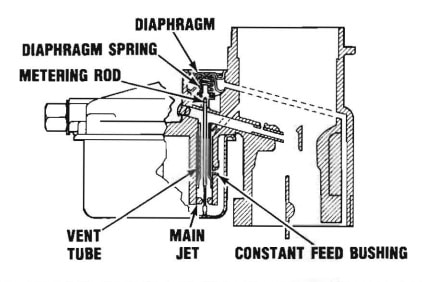Fuel for most part throttle and full throttle operation is supplied through the high-speed circuit. As intake manifold vacuum is a direct indication of engine load, a vacuum controlled diaphragm step-up rod provides instantaneous response to engine demands.
During part throttle operation, the relatively high vacuum from the intake manifold is transferred through a passage in the casting to the upper surface of the spring-loaded diaphragm to which the step-up rod is attached.

Manifold vacuum, in opposition to the calibrated spring, provides an economical air-fuel mixture control to the engine at all times, except when full power is required. When the diaphragm is up, the larger diameter (lower end) of the step-up rod is in the jet to provide the economy mixture.
As the throttle is opened, manifold vacuum is decreased. When the difference in pressure applied to the two sides of the diaphragm is not great enough to offset the downward pressure of the calibrated spring, the diaphragm moves downward and the step-up rod, attached to the diaphragm, is lowered in the jet.
The smaller diameter of the rod permits the metered increase in fuel flow to provide for additional power requirements.
During acceleration, the same action takes place to richen the fuel mixture for the power needs. However, the step-up rod is raised in the jet as soon as the manifold vacuum indicates the need for a less rich fuel mixture.
A vent tube with calibrated holes is pressed in place within the high speed well around the step-up rod.
A metered amount of air is admitted from the bore of the carburetor to the annulus around the vent tube. This air passes through the side holes in the vent tube to mix with fuel before it flows through the nozzle into the air stream. This aerated fuel known as an “emulsion” permits immediate fuel atomization as it emerges from the tip of the nozzle to assure equal distribution of fuel to each of the engine cylinders.
This action is further enhanced by two additional air bleeds – one in the venturi strut and the other in the upper tip of the nozzle.

